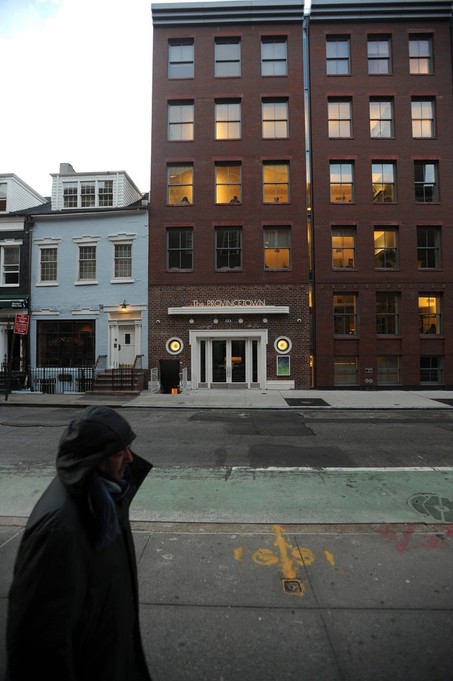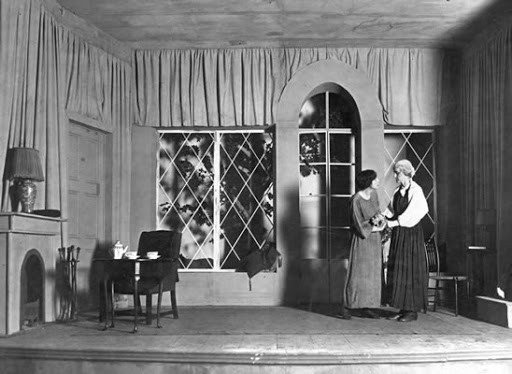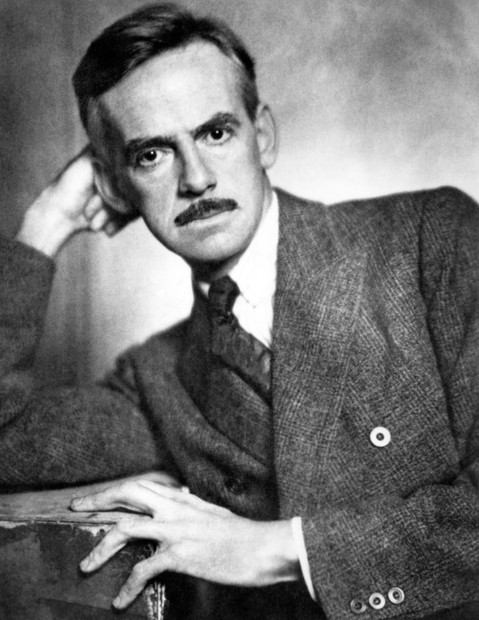Former Location of Provincetown Playhouse
Introduction
Text-to-speech Audio
Images
The location of Provincetown Playhouse as it appears today

The theater as it appeared in the early 20th century
.jpg)
A performance at the theater

Eugene O'Neill

Backstory and Context
Text-to-speech Audio
As its name suggests, the Provincetown Playhouse began in Provincetown, Massachusetts, in 1915. It began among a group of artists and writers who were vacationing together in a rented beach cottage. The group performed two plays on the cottage’s veranda and when word of the performances began to spread, they put on more performances in a former fish house turned makeshift theater. The following summer, even more writers and artists arrived in Provincetown after hearing about the group’s performances.
After the summer of 1916, the group decided to form a permanent organization, which would be based in Greenwich Village, where many of them lived. The organization’s purpose was primarily to provide an outlet for emerging playwrights, particularly those with an interest in realism rather than the melodrama which was then in vogue. The group moved to New York City in the fall of 1916 and converted the parlor of an apartment at 139 MacDougal Street into a theater. The location was a fortuitous one; it was in the heart of the Village, next door to both the Liberal Club and Polly Holladay’s restaurant, both of which were popular haunts of the neighborhood’s bohemian set.
While still in Provincetown, a young Eugene O’Neill became involved in the Players. In the Village, several of the playwright’s works were produced, including Bound East for Cardiff and Before Breakfast. In the first two years of the theater, O’Neill would have several other works brought to the stage, some of which would later be performed on Broadway.
In the 1918-19 season, the New York City Building Commission forced the group to stop using 139 MacDougal as a theater. They found a building owned by their landlord three doors down at 133 MacDougal. They began renting the former stable and added a scenery shop and dressing rooms, as well as offices upstairs. By this point, Edna St. Vincent Millay was working with the Players as an actor and within a few years would herself become an acclaimed playwright and poet.
The Provincetown Playhouse would continue to produce influential and experimental performances well into the twentieth century and served as a training ground for some of the most revered playwrights in American cinema. O'Neill alone would go on to win the Pulitzer Prize four times as well as the Nobel Prize for Literature. Both Bette Davis and Claudette Colbert made their New York stage debut in the theater. Edward Albee and Sam Shepherd had plays staged at the playhouse and Charles Busch's Vampire Lesbians of Sodom ran for five years at the theater, becoming one of the most successful Off Broadway plays in history.
In 1984, NYU purcahsed several of the townhouses on MacDougal Street, including the building which housed the Provincetown Playhouse. Despite the objections of preservationists and the theater community, the university demolished virtually all of the theater, leaving little more than the facade and a theater that holds the same name.
Cite This Entry
Woodham, Rebecca and Clio Admin. "Former Location of Provincetown Playhouse ." Clio: Your Guide to History. December 7, 2020. Accessed August 3, 2025. https://theclio.com/entry/19996/tour/8
Sources
Pogrebin, Robin. Rebuilt Theater Opening Amid Debate , New York Times . December 10th 2010. Accessed December 1st 2020. https://www.nytimes.com/2010/12/11/theater/11playhouse.html.
A History of the Provincetown Playhouse , Provincetown Playhouse . Accessed December 1st 2020. http://www.provincetownplayhouse.com/history.html.
Apmann, Sarah Bean. The Birth of the Provincetown Playhouse , Village Preservation . November 3rd 2017. Accessed December 1st 2020. https://www.villagepreservation.org/2017/11/03/the-birth-of-the-provincetown-playhouse/.
